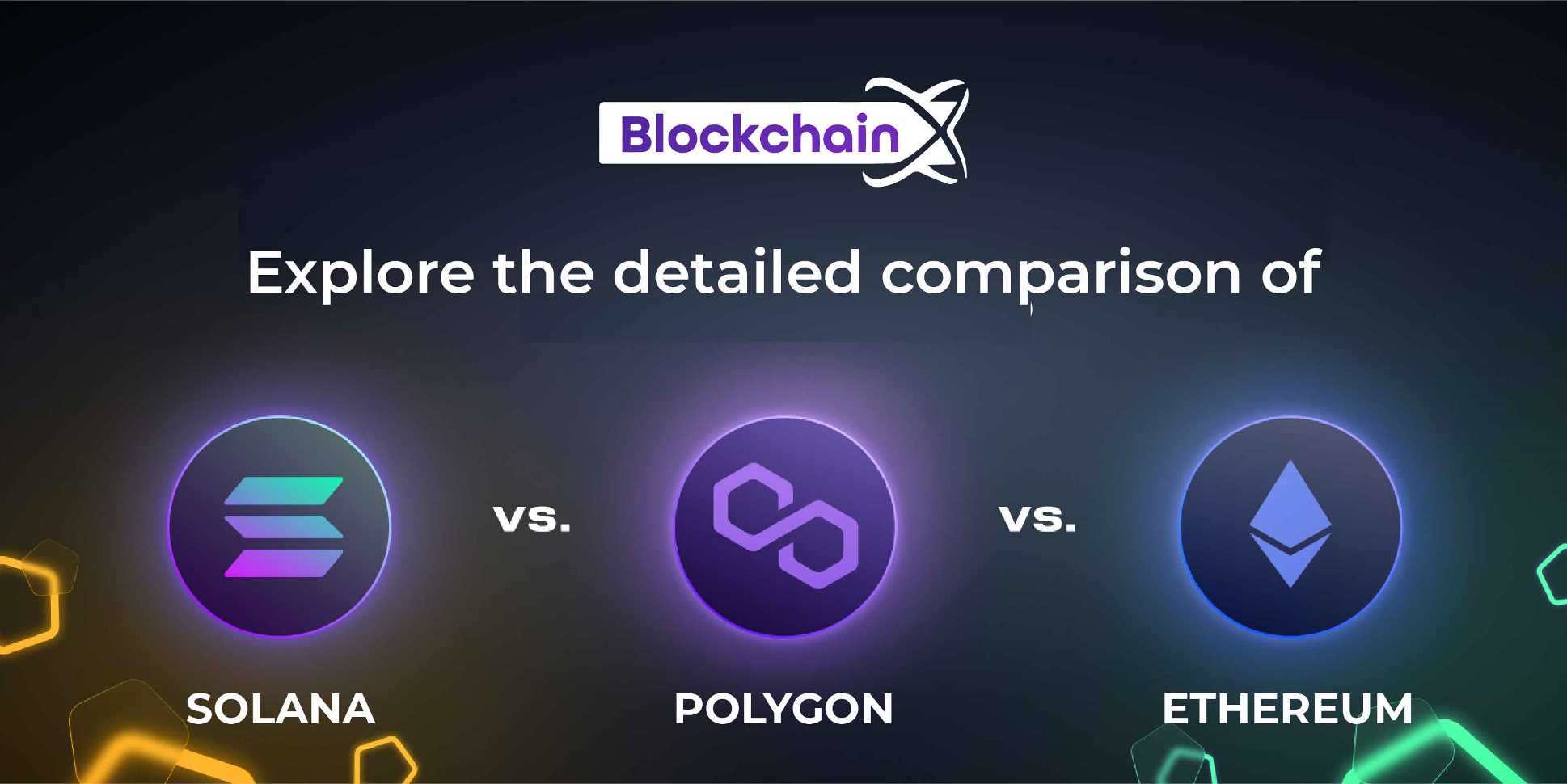A few years ago, no one thought about how blockchain and cryptocurrency would change the world. Today, we are witnessing the emergence of new business models based on blockchain technology. Leading trends like NFTs and decentralized finance have become the most talked-about terms in modern times. As the demand for blockchain-based solutions continues to grow, the need for blockchain platforms to develop such solutions has also evolved extensively.
The comparison of Solana vs. Polygon vs. Ethereum brings its footnote rapidly from such concerns and has also grown considerably. Ethereum is one of the oldest and most used blockchain platforms, new players in the Polygon and Solana market, providing faster and more generous transactions for users. While Ethereum is a major leader in terms of the blockchain platforms based on which most applications are built, its competitors are still trying to offer more.
In this article, you will find the difference between Solana, Polygon, and Ethereum based on various factors. You can identify the right best choice from the three competitors according to their abilities in different fields.
Why should you concentrate on Solana vs. Polygon vs. Ethereum comparison?
Before you choose a blockchain platform to build your apps, make sure the value doesn't affect it. Cryptocurrency values are for trading alone. Ethereum is a greatly diverse platform in terms of blockchain application development. With Ethereum 2.0, it has more features and developments than any other competitor. Ethereum launched the market where blockchain platforms were used for NFTs and smart contracts. This led to further growth of the market and the birth of competitors like Polygon and Solana. While Solana provides great competition to the Ethereum platform, Polygon is behind it. Solana offers faster transactions at lower costs compared to Ethereum and Polygon, while Polygon provides faster transaction speeds. However, Ethereum still exists as the most distinct and transparent landscape of decentralized applications.
This blog will let you understand the main differences between the three blockchain platforms and which option you should choose based on the application you want to develop. Architecture, consensus, scalability, and speed of transaction are the major standards on which the blockchain platform will be determined.
While the Ethereum platform is more about features and protection, Solana and Polygon are more about affordable rates, quick speeds, and scalability. Before looking at the differences between the three, let's see what the three blockchain platforms are.
Ethereum
Ethereum is currently the second most important blockchain platform after Bitcoin. It provides the resources needed not only for cryptocurrency but also for developing decentralized applications. Blockchain platforms have successfully built an efficient and open economy.
With its data-efficient services and numerous applications, Ethereum also facilitates accessibility for everyone, regardless of background or location. It is also significant to note that all programs connected to Ethereum assign intensive computing power. The platform has been an effective influencer in increasing the demand for digital collections. As a result, it enjoys being the initial choice for service providers offering the development of the NFT marketplace.
Solana
The next leading entry in comparison to Solana vs. Polygon vs. Ethereum draws our attention to another decentralized blockchain network. Solana blockchain is designed to develop highly scalable and user-oriented applications. The blockchain network is currently the quickest and offers one of the fastest and most efficient ecosystems. Blockchain developers can make the most of the efficiency and transaction speed related to the Solana network.
You can handle around 3000 transactions per second on the platform while it can handle 50,000 to 65,000 transactions per second. So, Solana is a strong competitor to other popular blockchain platforms.
Polygon
Polygon is also another top entry in blockchain platforms known for expanding new digital assets and economies. Also known as the Matic Network, it is the blockchain Internet for Ethereum. That sounds pretty confusing, doesn't it? Well, if you look closely, you will see that it focuses on allowing the multichain ETH ecosystem.
The most fascinating highlight about Polygon is that the network provides interoperability with all recent and future infrastructure scenarios for ETH. In addition, Polygon is designed to offer interoperability with new layer 2 solutions. Most importantly, the speed of transactions in a matic network has the promising advantage of being the fastest.
Differences between Solana, Polygon, and Ethereum
| Criteria | Ethereum | Solana | Polygon |
|---|---|---|---|
| Native Token | ETH | SOL | MATIC |
| Year of Foundation | 2013 | 2017 | 2017 |
| Programming language | Solidity |
|
|
| Transaction Speed | 13 -15 per second | 50000 - 65000 per second | Almost 65000 per second |
| Consensus Mechanism | Proof of work | Proof of stake, Proof of history | Proof of stake, Plasma-based blockchain |
| Architecture | Stateful architecture | Stateless architecture | Multichain architecture |
| Scalability | Limited scalability | High-Performance protocol for scalability | Multi-chain solutions offer better scalability |
With a basic overview of all the player's comparisons, Solana vs Polygon vs Ethereum, it is reasonable to point out the differences between them and will now discuss the main differences between the three blockchain platforms that make them adequate for multiple blockchain applications.
Consensus
It is a mandatory process that you will find among all decentralized blockchain platforms. It helps to reach an agreement on the recent state of the network. The Ethereum that follows is a proof of work or PoW mechanism of consensus. The problem with Ethereum is the need for high processing power. Because of this, it does not allow multiple users to participate, although it does enable miners to participate in a global consensus. As processing power requirements are high, it also affects performance but assures better safety.
With Polygon, you can get consensus based on PoS or proof of share. If a user uses a polygon network, they can receive rewards in a Matic taken. It offers a combination of technology, so consensus can be reached faster.
Solana, on the other hand, has a different approach to the consensus mechanism. It provides the fastest transaction speed, and the machine provides efficient operation. It uses a series of calculations to determine the ideal verification method for the time gap between two events. It can be said to be a composite form of consensus with the best features of PoW, PoS, and PoH, which is proof of history. It permits more flexibility in sorting transactions. That's why Solana can do up to 65,000 transactions a second.
Transaction Speed
The speed of transactions on blockchain platforms is a key factor that helps developers determine the platform they need to work on. The slowest of these is Ethereum when it comes to transaction speed. Now each participant in Ethereum has a copy of the digital ledger, and the holder takes care of the operation and management of the network. Now Ethereum is one of the most used and prominent blockchain platforms, due to which it has a lot of crowds to check its transactions.
Therefore, the participant will either have to wait longer or pay a larger fee for verification. Because of this, only a limited number of transactions are made per second, which can be between 13 and 15.
Solana and Polygon are way ahead in terms of transaction speed and offer 50,000-65,000 transactions per second which are very fast. Solana TBFT's Tower Byzantine fault tolerance prevents real-time communication between nodes and reduces the time taken, increasing widespread efficiency. Polygons, on the other hand, have the fastest speed. As it provides a hybrid environment, it has the fastest transaction speed of 65,000 transactions per second.
Architecture
Another significant factor that developers consider is architecture. The architecture interprets the state of the blockchain network and if it can alter variable values. Ethereum is undoubtedly one of the best stateful architectures in the competition which is why it is widely used for creating apps on blockchain platforms. The platform records all transactions in their current state and copies of the latest transactions are instantly made to reflect recent transactions. It is an effective network but it is slow compared to a stateless network.
Polygon comes up with the idea of a borderless society and economy where it serves like a POS blockchain and exchanges are present in the form of clusters. Solana on the other hand is based on the cluster architecture that works on Solana clusters. It is a collection of validators that address client transactions together with ledger maintenance.
Each cluster has its validator and the roles of each validator revolve between them. The leader of the cluster will create and timestamp the transaction with PoH consensus. It is stateless architecture and because of this, the entire state of Solana architecture does not require updating every time. That's why both Solana and Polygon are very efficient and offer fast transactions.
Scalability
One of the most crucial factors a developer should consider before choosing a platform for blockchain app development. It shows whether the network is scalable to assure the completion of the transaction. With Ethereum, the transaction speed is 15 transactions per second, which is low compared to competitors.
However, Layer 2 scaling with multichain network support solves the scalability problem. Solana can process up to 50,000 transactions per second, due to which scalability issues do not exist. Users have access to faster transaction speeds, better consensus models, and efficient architectures. Polygon offers the same scalability as Solana with exceptional transaction speed.
Famous projects
Ethereum has done projects like Cryptokitty, Crypto Punks, OpenSea, Decentraland, Rarible, and Nifty Gateway.
Solana has done projects such as Degenerate App AcademySolpunks, Solsea, and Sollamas.
Polygon has a Plasma-enabled sidechain, Easy Fi, QuickSwap, PoS SportX, and ZED RUN.
To wrap it all up
So here's the difference between the three most popular blockchain platforms used by blockchain app developers around the world. The use of all three platforms will depend on the type of application that will be developed. This blockchain platform is rapidly gaining attention in the market due to the kind of application and utility it offers. Also, the crypto space continues to boom, you will see a huge increase in the use of this platform in the future. Using this platform, users can invest their time in DeFi and NFTs, which are currently the biggest trends in the world of blockchain. It is entirely up to the user to decide which of the three platforms they want to use for DeFi and NFT.
For now, Ethereum is a stronghold on the market for deFi and NFTs as it was the basis for the evolution of NFTs and developers still prefer Ethereum for it. However, with the rise of crypto completion, platforms like Solana and Polygon are gaining a lot of popularity.
If you are new to the crypto market or have recently entered the NFT and Defi market, this article will help you understand which platform is better for you to invest your time and resources. Overall, if you are looking for the most reliable platform with security and features, it will be Ethereum. However, if you are looking for affordable capability and fast speed, it would be better to choose Solana or Polygon.

